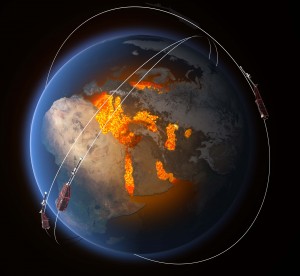Today’s (7/7/2014) Metro newspaper has a nice article in the Metrocosm section by Ben Gilliland entitled “Portends of magnetogeddon” . Apart from the slight alarmism, it’s (as usual with Ben) pretty good, and I’m pleased to see him talk up the magnetic field even more than I usually do! It seems to be driven by the current ESA satellite mission Swarm, which is measuring the near-Earth magnetic field with the best ever satellite instruments on three separate spacecraft, with a view to separating magnetic sources external to the Earth (like the sun, auroral currents, and the magnetosphere) and those internal (from the core, and from magnetised material at Earth’s surface). However, much of the article is focussed on more general information, such as magnetic reversals (well known to readers of this blog!) and the possible effects of weakening of the field. That the field is dropping in magnitude is not a new result – we’ve known this for a century or so, and now have evidence that this has been happening for at least 400 years (and probably longer) but it gets a lot of publicity every time we have new measurements – I remember something similar happening when the Ørsted mission was launched in 1999. There was a nice documentary on this over 10 years ago, joint between WGBH Nova for PBS in America, and Channel 4 in the UK called “Magnetic Storm” (“Magnetic flip” in the UK) from which most of the information is still accurate. If you are interested, you can find it online. The issue is that the magnetic field provides us with a shield from harmful solar and cosmic radiation, and so if it weakens (and potentially reverses), this shield would be weakened. However, the answer to the initial question is
Don’t Panic!
(Readers of a certain age may recognise the source of both this response and the slight misquote of the title…..) The answer from the documentary is that the field will weaken, but not completely disappear, it isn’t going to happen for the next 1000 years or so if it does then, and even if it does, the protective measures required will be not to lie on the beach in Florida, and to wear a large floppy hat!
Whether the field is reversing is not known, and (to an extent) not knowable. We have models made from observational data and palaeomagnetic measurements (some created here at Liverpool) which show that in the last 10,000 years, the magnetic field has both decayed more rapidly than it is at present, and been substantially weaker than it is now, but then recovered. Therefore, the current fall in the magnetic field could be simply part of its normal variation. Things are a little more complicated, as there is a strong and growing feature of the “wrong” polarity at the surface of the Earth’s core under the South Atlantic, giving rise to the weaker area of field that we see as the “South Atlantic Anomaly” – which causes occasional havoc in the instruments of satellites flying overhead. This feature could be a signature of a major change in the field, but it could also simply reflect rearrangement of magnetic field at the core – if this becomes more complicated, it could look weaker from the surface without the field itself actually getting any weaker.
What Swarm is really for is getting a much more detailed picture of small-scale structures in the magnetic field, and its rapid changes on time scales of years – so magnetic “weather”, rather than the “climate” of a field reversal. Hopefully, this will give us a much better idea of these smaller variations – my interest is particularly in comparing these variations with changes in Earth rotation. If this work is successful, we may yet also have something to say about the longer term decline in the field, although I can guarantee that this won’t affect anyone for many lifetimes to come!
Today’s post was guest written by Richard Holme. Richard Holme is Professor of Geomagnetism at the University of Liverpool. His research interests are in the behaviour of the magnetic fields of the Earth and other planets on timescales of milliseconds to billions of years, and variations in Earth rotation and their link to Earth’s core. He is involved with the ESA geomagnetic mission Swarm, is looking forward to July 2016 for Juno to arrive at Jupiter, 2017 for Cassini to begin close orbits of Saturn, and 2033 (?!) for the arrival of Juice at Ganymede.



Leave a Reply